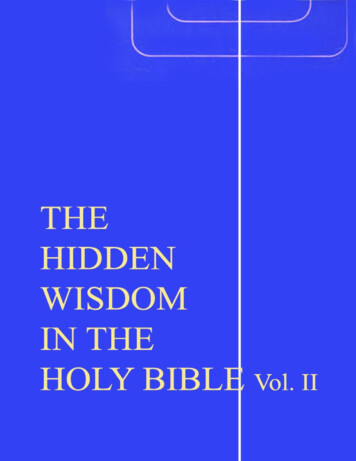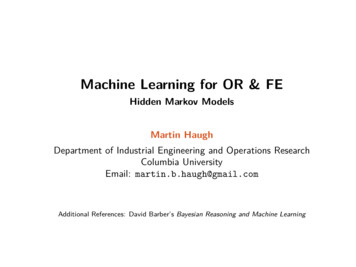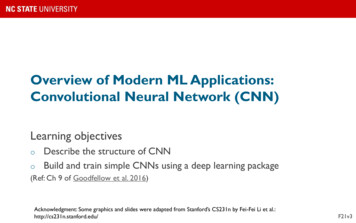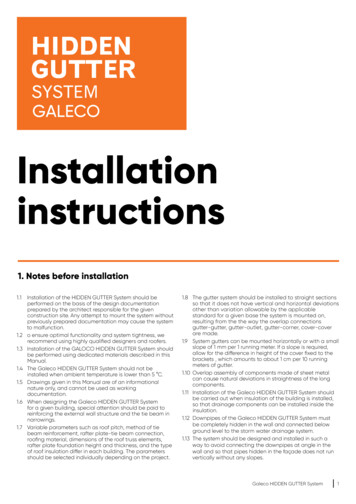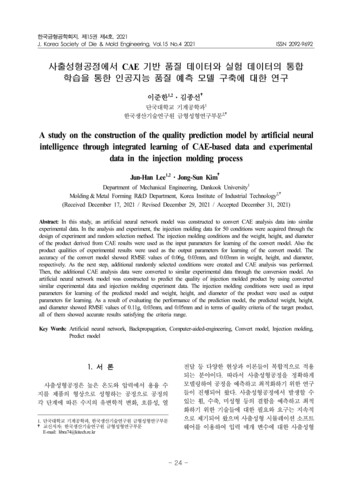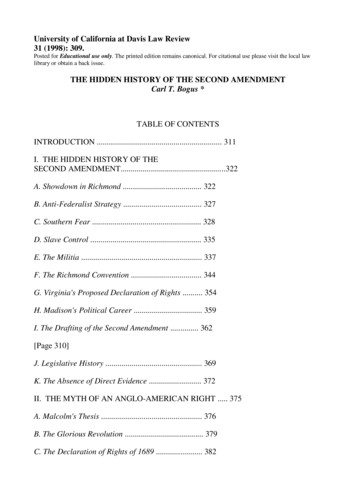
Transcription
University of California at Davis Law Review31 (1998): 309.Posted for Educational use only. The printed edition remains canonical. For citational use please visit the local lawlibrary or obtain a back issue.THE HIDDEN HISTORY OF THE SECOND AMENDMENTCarl T. Bogus *TABLE OF CONTENTSINTRODUCTION . 311I. THE HIDDEN HISTORY OF THESECOND AMENDMENT.322A. Showdown in Richmond . 322B. Anti-Federalist Strategy . 327C. Southern Fear . 328D. Slave Control . 335E. The Militia . 337F. The Richmond Convention . 344G. Virginia's Proposed Declaration of Rights . 354H. Madison's Political Career . 359I. The Drafting of the Second Amendment . 362[Page 310]J. Legislative History . 369K. The Absence of Direct Evidence . 372II. THE MYTH OF AN ANGLO-AMERICAN RIGHT . 375A. Malcolm's Thesis . 376B. The Glorious Revolution . 379C. The Declaration of Rights of 1689 . 382
III. THE MYTH OF AN INSURRECTIONIST RIGHT . 386A. Modern Insurrectionist Theory . 386B. Were the Founders Insurrectionists? . 390IV. THE MYTH OF THE SELF-APPOINTED MILITIA . 405CONCLUSION . 407[Page 311]For the great enemy of the truth is very often not the lie deliberate, contrived, anddishonest but the myth persistent, persuasive, and unrealistic. Too often we holdfast to the cliches of our forebears. We subject all facts to a prefabricated set ofinterpretations. We enjoy the comfort of opinion without the discomfort of thought.-John F. Kennedy[1]INTRODUCTIONThe Second Amendment is unique. No other constitutional provision has lived so small alife in the law while looming so large in the realms of policy, politics, and popularculture. Among the Bill of Rights, only the Third Amendment, which prohibits thequartering of troops in homes, has received less judicial attention.[2] Annotations of allthe cases that have dealt with the Second Amendment take up a mere ten pages in theUnited States Code Annotated, compared, for example, to 1452 pages for FirstAmendment cases.[3] In the history of the republic, the United States Supreme Court hashanded down only three opinions dealing directly with the Second Amendment,[4] thelast in 1939,[5] and no federal statute or administrative regulation has ever beeninvalidated on Second Amendment grounds.Based on this lack of activity, one might expect the Second Amendment to be somethingof a constitutional relic, obscure [Page 312] and forgotten. That is hardly the case. Theright to bear arms is invoked constantly on the political stump, the op-ed page, the radiotalk show, and the floors of Congress.[6] Politicians of all persuasions consider itessential to pledge fealty to the right to bear arms, often in extravagant terms.[7]According to Senator Orrin Hatch, who currently chairs the Senate Judiciary Committee,the right to bear arms is the "right most valued by free men."[8] While most Americansmay not consider the right to bear arms more precious than freedom of speech orreligion, few constitutional provisions are more familiar to the public-at-large. Onenational poll showed that more Americans know that the Constitution contains a right tobear arms than know that it guarantees a right to remain silent if accused of crimes.[9]There can be little doubt that the Second Amendment has a powerful impact on publicpolicy. The United States is the only industrialized nation in the world in which tens of
thousands of citizens are killed or wounded by guns each year.[10] [Page 313]Consequently, the United States is far and away the leader in criminal homicide in theindustrialized world.[11] Efforts to reduce handgun violence through legislation is by nomeans a hopeless cause. Research demonstrates that stringent handgun regulation candramatically reduce murder, robbery, and suicide;[12] yet except for modest legislation,such as the Brady Act,[13] the United States neither has nor is seriously considering aneffective system for regulating handguns in the United States.[14] The SecondAmendment is part of the reason that the United States tolerates a level of carnage andterror unparalleled [Page 314] in any other nation at peace.[15] The public more or lessassumes that the Second Amendment prohibits the kind of gun control regulations thateffectively protect public safety in other countries.[16]Exactly what the parameters of the right to bear arms are and why the Foundersconsidered it sufficiently important to include it in the Bill of Rights may seem amystery shrouded by mists of time. The words of the Second Amendment are familiar tomany Americans: "A well regulated Militia, being necessary to the security of a freeState, the right of the people to keep and bear Arms, shall not be infringed."[17]Americans have an image of the militia minutemen rushing with muskets onto thegreens at Lexington and Concord to fire the "shot heard around the world."[18] The factthat colonists were armed helped make the Revolution possible. Indeed, it was a Britishplot to confiscate American militia weapons that propelled Paul Revere on his famousride.[19] These images blend with other visions of colonial America. Many believe gunsand survival went hand-in-hand in early America that settlers depended upon firearmsto defend themselves from Indians, thieves, and wild animals, as well as to hunt forfood.[20] Some assume that the Founders incorporated the right to bear arms in the Billof Rights because an armed citizenry had been important to security in colonial Americaand essential to throwing off the yoke of British oppression.[21]Much of this is myth. It is not myth in the sense that the images are wholly divorcedfrom historical truth. Rather, myths can be powerful and sinister because they blend factand fiction. [Page 315] Myths do not so much misrepresent as mislead, not so muchconcoct as distort. That is the case with the Second Amendment. When the Bill of Rightswas adopted, some believed that the right to bear arms was important to defend and feedcitizens and their families or to resist foreign aggression and domestic tyranny.[22] But,as this Article will show, that was not the principal reason that the Founders created theSecond Amendment.The story of the Second Amendment is both more complex and more interesting thanpreviously understood. It is a tale of political struggle, strategy, and intrigue. The SecondAmendment's history has been hidden because neither James Madison, who was theprincipal author of the Second Amendment, nor those he was attempting to outmaneuverpolitically, laid their motives on the table.Before describing this hidden history, I wish to briefly explain why it is particularlyimportant for scholars and courts to understand this hidden history and why this historywill encounter great resistance. While in the past scholars have not ignored the SecondAmendment quite as much as the courts, even within academic circles it was a
reasonably dormant topic. Then about a decade ago, things changed; suddenly there wasan explosion of academic interest in the Second Amendment. The Second Amendmentbecame the subject of a constant stream of books,[23] articles,[24] conferences,[25]symposia,[26] and even entire [Page 316] organizations.[27] This is not the result ofmere chance; it is part of a concerted campaign to persuade the courts to reconsider theSecond Amendment, to reject what has long been a judicial consensus, and to adopt adifferent interpretation one that would give the Amendment judicial as well aspolitical vitality and would erect constitutional barriers to gun control legislation.The Second Amendment has been the subject of so little judicial activity because courtshave unanimously adopted what is generally referred to as the "collective rights"theory.[28] According to this view, the Second Amendment grants people a right to keepand bear arms only within the state-regulated militia. In contrast, those who advocate an"individual rights" theory believe that the Second Amendment grants individuals apersonal right to keep and bear arms. This model has long been advocated by the firearmindustry, shooting organizations, and political libertarians.[29] However, state[30] andfederal courts[31] consistently ad-[Page 317] hered to the collective rights interpretation,and it became clear that further head-on assaults would likely be counterproductive. Thegun lobby apparently decided to suspend efforts to have the courts reconsider the SecondAmendment until a body of secondary authority could be developed to support itsposition.For a period of time, legal challenges to gun control legislation studiously avoided theSecond Amendment. The challenge to the Brady Act, for example, was madeexclusively on Tenth Amendment grounds.[32] Meanwhile, the gun lobby pursued anaggressive campaign to build a body of favorable literature. An arm of the National RifleAssociation ("NRA") dispensed sizable grants to encourage writing that favored theindividual rights model, and even stimulated student articles with a Second Amendmentessay contest.[33] Gun rights advocates then decided that the project had borne enoughfruit to return to the courts. In an amicus brief asking the Court to grant certiorari andreconsider the right to bear arms in its 1996-97 term, a group calling itself Academicsfor the Second Amendment told the Court that thirty-seven of forty-one law reviewarticles addressing the topic since 1980 endorse the individual rights position.[34] [Page318]The bulk of this writing has been produced by a small band of true believers who belongnot merely to the individual rights school of thought but a particular wing commonlycalled "insurrectionist theory."[35] The leader of this band is Stephen P. Halbrook,[36]who, with the support of tens of thousands of dollars in NRA grants,[37] has written noless than two books and thirteen law review articles advocating this particular theory ofthe Second Amendment.[38] Insurrectionist theory is premised on [Page 319] the ideathat the ultimate purpose of an armed citizenry is to be prepared to fight the governmentitself. Halbrook believes that "the Second Amendment's framers anticipated a force ofthe whole armed populace, not a select group, to counter inroads on freedom bygovernment,"[39] and that they intended "to guarantee the right of the people to have.their private arms' to prevent tyranny and to overpower an abusive standing army orselect militia."[40] Such writings conjure up a romantic image of the colonial militia:
rugged individualists who answer to no one but their own conscience and stand ready toprotect their homes, families, and communities from all manner of threats, both foreignand domestic. Because they serve no master other than their own sense of patriotism,they cannot be manipulated or commandeered as might a government controlled force.Because they are armed, they have the means, as well as the will, to resist tyranny.Despite a surface allure, Halbrook paints a dismal picture. It is animated by a profoundmistrust not only for government, but for constitutional democracy. For Halbrook, all ofthe constitutional mechanisms ensuring that government power will not bemisused the division of power between the federal and state governments, theseparation of powers among the three branches of government, a bicameral legislature,an independent judiciary, freedom of speech and the press, and a civilian Commander inChief are inadequate.[41] He is afraid the constitutional structure will fail. WhenHalbrook speaks of an armed citizenry as necessary to "counter inroads on freedom bygovernment"[42] and "prevent tyranny and to overpower an abusive standing army,"[43]he is arguing that the constitutionally elected [Page 320] government will itself becomethe enemy. In short, Halbrook believes both that the ultimate guarantee of freedom mustcome from the barrel of a gun and that the Founders believed this as well.Insurrectionist theory may be paranoic, anarchistic, and anti-democratic, but it is atheory that has won some important converts. While, as a general matter, mainstreamscholars have only a cold disdain for the work of insurrectionist theorists,[44] at leastthree prominent constitutional scholars Sanford Levinson of the University ofTexas,[45] Akhil Reed Amar of Yale,[46] and William Van Alstyne ofDuke[47] have recently joined the insurrectionist school, giving it a respectability itdid not previously enjoy. "This was a frivolous, crazy position, and it no longer isanymore," Cass R. Sunstein remarked.[48]The campaign to have the Supreme Court reconsider the Second Amendment may bewinning converts within the Court [Page 321] as well. In his concurring opinionin Printz v. United States,[49] Justice Thomas took note of the "growing body ofscholarly commentary" supporting the view that the Second Amendment grants anindividual right.[50] Justice Thomas hinted that he agrees with the individual rightsposition and suggested that "[p]erhaps, at some future date, this Court will have theopportunity to determine" the meaning of the Amendment.[51]This Article challenges the insurrectionist model. The Second Amendment was notenacted to provide a check on government tyranny; rather, it was written to assure theSouthern states that Congress would not undermine the slave system by using its newlyacquired constitutional authority over the militia to disarm the state militia and therebydestroy the South's principal instrument of slave control. In effect, the SecondAmendment supplemented the slavery compromise made at the ConstitutionalConvention in Philadelphia and obliquely codified in other constitutional provisions.[52]Part I of this Article relates the hidden history of the Second Amendment. In many ways,the story begins in June 1788 at a convention in Richmond at which Virginia was todecide whether to ratify the Constitution of the United States. However, before relating
the events at Richmond, Part I provides some background involving slavery, slavecontrol, the militia, and the dynamics of the struggle between the Federalists and antiFederalists as they headed toward a showdown in Richmond. Part I then describespolitical events occurring after Richmond which persuaded Madison to write a bill ofrights, including the provision we now know as the Second Amendment.Part II of this Article tells a different part of the story, one that occurred a hundred yearsbefore Madison wrote the Second Amendment. Insurrectionist theorists increasinglystress what they call the Anglo-American legacy of the right to keep and bear arms.They argue that the Second Amendment is a direct descendant of the EnglishDeclaration of Rights of 1689, which, they contend, granted an individual right to havearms as a [Page 322] check on governmental tyranny. Part II focuses on the Declarationof Rights, placing it and its right to have arms provision in the context of the British"Glorious Revolution." This Article does not quarrel with the premise that the SecondAmendment was inspired by the Declaration of Rights. On the contrary, it tries toilluminate the parallels between the two provisions, showing that Madison wrote theSecond Amendment to address a problem analogous to the one faced a century earlier bythe authors of the Declaration of Rights. This Article argues that the insurrectionistinterpretation of the Declaration of Rights is fundamentally flawed. An historicallysound understanding of the Second Amendment's English heritage belies the propositionthat the Second Amendment was intended to grant an individual right to keep or beararms against governmental tyranny. Instead, the Amendment's English heritage providesfurther support for the hidden history of the Second Amendment.Parts III and IV respond to opposing arguments. Modern insurrectionists claim theFounders as their own, offering many quotes from venerated figures of the early republicthat appear to endorse the idea of the right to keep and bear arms against governmenttyranny. Part III takes up the question of whether the Founders were insurrectionists.Part IV deals briefly with the insurrectionists' claim that the word "militia," as used inthe Second Amendment, means a militia composed of all able-bodied, adult citizens. TheArticle concludes by offering final thoughts on the implications of the SecondAmendment's hidden history.I. THE HIDDEN HISTORY OF THE SECOND AMENDMENTA. Showdown in RichmondThe story of the hidden history of the Second Amendment begins in June 1788 at aconvention, held in Richmond, to consider whether Virginia would ratify theConstitution of the United States. The Constitution had been a controversial documentsince its adoption in Philadelphia in September 1787.[53] [Page 323] Though theFederalists, who favored a stronger federal government, did not achieve all they desired,they were the perceived victors at the Constitutional Convention.[54] The antiFederalists were now engaged in a campaign to stop the Constitution from beingratified.[55]
The anti-Federalists were skeptical, even bitter, about the ratification process. Some feltthat the Philadelphia Convention had exceeded its authority, that the delegates shouldhave interpreted their charge as one to modify the Articles of Confederation, not tocreate a radically different structure.[56] They were further irritated by the fact that theConstitution would become effective not by the unanimous consent of the Union'sthirteen states but by the ratification of only nine.[57] Moreover, the state legislatureshad been cut out of direct participation in the process; the Constitution would be putbefore state ratifying conventions rather than the state legislatures.[58]From the moment the Convention proposed the Constitution, both sides had beenengaged in a struggle over ratification. There was, of course, a scintillating debate ofideas. John Jay, James Madison, and Alexander Hamilton argued for ratification in aseries of essays published in New York newspapers under the pseudonym "Publius,"which today are collectively known as The Federalist Papers.[59] Meanwhile, antiFederalists wrote essays opposing ratification. Those published under the names [Page324] "Brutus,"[60] "Centinel,"[61] "John Dewitt,"[62] and "The Federal Farmer"[63]were among the most prominent.The battles were not limited to an exchange of ideas, however. This was a no- holdsbarred struggle, and the adversaries pressed every available strategic or tacticaladvantage. The following example gives a sense of the intensity of the struggle. The dayafter delegates to the Philadelphia Convention signed the proposed new Constitution,Federalists sought to have the Pennsylvania Legislature, which had been meetingupstairs at the Philadelphia State House while the Constitutional Convention was insession downstairs, vote to convene a ratifying convention in Pennsylvania two monthshence.[64] Lacking the votes to defeat this proposal, the anti-Federalists sought to blockthe measure by failing to return after the noon recess, thereby preventing a quorum.[65]The legislative session was due to end the next day, and without a quorum there wouldbe considerable delay before the Pennsylvania Legislature could consider the matteragain.[66] The Federalists, capitalizing on the opportunity to create a sense ofmomentum by having Pennsylvania vote to convene a ratifying convention before theink had dried on the proposed new Constitution, directed the sergeant of arms to fetchthe missing members.[67] The sergeant located two just [Page 325] the numberneeded to complete a quorum escorted them against their will back to their seats inthe State House, and barred the doors until the assembly voted by a narrow margin toconvene a state ratifying convention.[68] For the anti- Federalists, this incident became asymbol of a Federalist campaign to steamroll the Constitution to ratification andheightened their resolve to resist.[69]Nine months later, the fate of the Constitution and, thus, the United States was in doubt.Eight states had ratified the Constitution; only one more was needed. But there was notanother state where ratification was certain or perhaps even likely. Rhode Island was asure bet against ratification. So unenthusiastic had it been about a strong Union in whichit would have little influence as a small state, Rhode Island had not even sent delegatesto the Philadelphia Convention.[70] New Hampshire and North Carolina were alsoconsidered likely to oppose ratification.[71] Though it was perhaps more unpredictable,New York too seemed unlikely to ratify. New York's Governor George Clinton was
opposed to ratification, and forty-six of the sixty-five delegates elected to the state'sratifying convention were committed anti- Federalists.[72][Page 326][Page 326]This left only Virginia. The stakes were enormous. Not only was Virginia critical as apossible ninth state, but because it was the largest[73] and one of the most prosperousand respected states[74] the home of George Washington, Thomas Jefferson, andJames Madison, among others it was by no means clear that the United States couldsucceed without it.[75] However, the prospect of Virginia's ratification wasuncertain.[76] Madison would serve as the principal advocate for ratification, and no oneunderstood the new Constitution better than Madison. Yet the opposition was equallyformidable. Virginia's anti-Federalist delegates included two of the three men who hadrefused to sign the Constitution in Philadelphia George Mason and the state'seloquent Governor Edmund Randolph[77] as well as Patrick Henry, who was themost famous orator of the day.[78] [Page 327]B. Anti-Federalist StrategyThe anti-Federalists were prepared to raise any argument that would win votes againstratification.[79] Their strongest ally was fear, and they raised a multitude of concernsabout the potential calamities under the new Constitution.[80] Among these was onetopic about which Virginia was already concerned and fearful the subject ofslavery.[81]One of Virginia's main concerns was that the federal government would abolish ordirectly interfere with the slave system. During the Constitutional Convention, PierceButler of South Carolina declared: "The security the Southn. States want is that theirnegroes may not be taken from them which some gentlemen within or without doors,have a very good mind to do."[82] Most believed that question had been settled inPhiladelphia. The Southern states had made it plain that they would not join the Union ifemancipation was an open issue and insisted that the Constitution protect the slavesystem.[83]Though the Constitution did not do so expressly, it included a number of provisionsdirectly related to slavery. Taken together, these provisions evidenced an agreement thatneither Congress nor the Northern states[84] would attempt to interfere with slavery inthe South. [85] Most believed this was sufficient. Charles [Page 328] Pinckney, one ofSouth Carolina's delegates to the Constitutional Convention, went home and told thestate house of representatives:We have a security that the general government can never emancipate them, for no suchauthority is granted and it is admitted, on all hands, that the general government has nopowers but what are expressly granted by the Constitution, and that all rights notexpressed were reserved by the several states.[86]Others wanted this principle expressly included in the Constitution and would soon seizeupon the opportunity to include such a provision in a bill of rights. A little over a yearlater, for example, William L. Smith of South Carolina wrote a letter urging adoption of
a proposed bill of rights because "if these amendts. are adopted, they will go a great wayin preventing Congress from interfering with our negroes after 20 years . . . . Otherwise,they may even within the 20 years by strained construction of some power embarrass usvery much."[87] The dominant view, however, was expressed by Pickney. Pickneybelieved that it was sufficiently clear that the new Constitution did not give the federalgovernment any authority that it could legitimately employ to abolish slavery.[88]Although the federal government could not abolish slavery directly, however, there wereways in which it might undermine the slave system indirectly. For the South, this was aterrifying prospect.C. Southern FearWhen the delegates to the ratifying convention met in Richmond on June 2, 1788, theyknew that the Northern states were increasingly disgusted by slavery. The Revolutionhad changed [Page 329] everything.[89] Americans had embraced an ideology groundedon the premise that "all men are created equal, that they are endowed by their Creatorwith certain unalienable Rights, that among these are Life, Liberty, and the Pursuit ofHappiness."[90] Although some sought to reconcile these beliefs with the continuationof the slave system,[91] for many, of course, that was impossible.From the start, revolutionary rhetoric was turned easily and sharply against the South."How is it that the loudest yelps for liberty come from the drivers of slaves?" Dr. SamuelJohnson had asked from England.[92] When Massachusetts effectively ended slavery in1783, it did so in a way that must have been profoundly embarrassing to the slave states.Based on language in the state constitution quite similar to that in the Declaration ofIndependence "that all men are born free and equal" and "that every subject is entitledto liberty" the Massachusetts Supreme Court held that the state constitution, adoptedthree years earlier, effectively abolished slavery.[93] [Page 330]Abolition fervor was running strongly in the North. Vermont, though not yet recognizedas an independent state, abolished slavery outright in 1777.[94] Pennsylvania,[95] RhodeIsland,[96] and New York[97] had all enacted gradual emancipation legislation. SomeNortherners were not satisfied with gradual methods. Frustrated by the failure to endslavery immediately, prominent New York citizens formed the New York Society forPromoting the Manumission of Slaves.[98] The first two presidents of this group wereJohn Jay and Alexander Hamilton.[99]The South must have realized that although the Constitution did not grant the federalgovernment the power to abolish slavery, it did not eliminate the desire to end the slavesystem. There were many in the North who continued to feel a moral imperative to bringslavery in America to an end.[100] Many in the South also railed against slavery, amongthem prominent Virginians such as Thomas Jefferson[101] and GeorgeMason.[102][Page 331] But there was a difference. The instinct among Northerners wasto emancipate slaves while Southerners tended to want to deport them.[103] This wasnot principally due to a more extreme racism in the South but to a legitimate fear aboutwhat would happen if it loosened its tight control over a black population that had longsuffered horrible cruelties.[104] Even more chilling than emancipation was the prospect
of continuing the slave system but weakening the white population's control over theslave population.[Page 332]Southerners, therefore, had to worry that Northerners, whether morally committed toending slavery or merely indifferent to the precarious situation in the South, mightsubvert the slave system indirectly. Even Virginians who wanted to end slavery had totremble at such a prospect. Virginia was a state living in perpetual fear.[105] Fully fortyfour percent of Virginia's total population was black,[106] and in some areas,particularly in the eastern part of the state, blacks constituted the majority. Whites wereever mindful that if the right opportunity presented itself, blacks might cut their headsoff.[107] This is not hyperbole. On a Sunday morning in September 1739, for example, agroup of about twenty blacks broke into a store near Stono, South Carolina for guns andpowder.[108] They decapitated the two storekeepers, displayed their heads on the frontsteps, and then headed South, sacking and burning homes and killing whites on theirway. They marched while flying banners, beating drums, and [Page 333] calling out"Liberty!" to attract more slaves to the rebellion.[109] According to one account, theirnumbers "increased every minute by new Negroes coming to them, so that they wereabove Sixty, some say a hundred."[110] But for a coincidence, the rebellion may havegrown considerably larger and perhaps even succeeded.[111] By chance, the LieutenantGovernor of South Carolina rode within eyesight of the rebel group while he was on hisway to Charleston with four other men.[112]As best as events can be reconstructed, the Lieutenant Governor raced to thePresbyterian church in Wiltown, which happened to be in the midst of Sunday services,and assembled a contingent of white planters.[113] By four o'clock in the afternoon,somewhere between twenty and one hundred armed and mounted militiamen attackedthe rebel group. About forty-four blacks and twenty-one whites died in the ensuingbattle.[114] As a warning against future insurrections, the militia decapitated blackrebels and placed their heads "up at every Mile Post they came to."[115] However, atleast thirty blacks escaped.[116] The entire white population was ordered under arms,and a desperate manhunt was c
Among the Bill of Rights, only the Third Amendment, which prohibits the quartering of troops in homes, has received less judicial attention.[2] Annotations of all the cases that have dealt with the Second Amendment take up a mere ten pages in the United States Code Annotated, compared, for example, to 1452 pages for First Amendment cases.[3]






